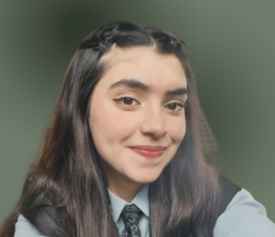The Renaissance of Art:
(From silence to voice, a story of empowerment)
Art is a powerful form of storytelling, conveying emotions, ideas, and experiences through
various mediums like painting, sculpting, poetry, and dance. Each art form has its unique
ability to connect people with the story being told. Art has been an integral part of human
existence since the dawn of our species. Artists always pour their feelings and perspectives
into their work, sometimes reflecting the society's narrative. But it wasn't in the Middle Ages
(5th-14th centuries), the Catholic Church's dominance stifled artistic expression. Artists were
forced to promote religious themes, suppressing intellectual exploration and creativity. This
period is often referred to as the "Dark Era".
Fortunately, time flies, and the Dark Era turned into the Renaissance (14th-16th centuries).
This era marked a resurgence of artistic innovation, particularly in painting, sculpting, and
architecture. Before talking about all this let's dive into the history of art first for better
understanding. For this let's start from scratch.
The “Prehistoric Era”,the first known period of art although we all know that art is with us
from the very start of our race but this is the first recorded era. This era has left us with some
remarkable examples of art, created by talented individuals such as the Harappa artists,
Rock artists, and Cave artists. Although their work was limited still they provide a glimpse
into the creative minds of our ancient ancestors.Some of the most dramatic examples of
prehistoric art have been found in the caves frequented by Stone Age humans, such as
Lascaux in France and Altamira in Spain.
This era marked the beginning of artistic expression, showcasing the significance of art in
human culture. This era works as the pioneer for art and set the stage for others like "The
ancient civilization".The dawn of ancient civilizations marked a significant milestone in the
evolution of art. As societies grew more complex, so did their artistic expressions. The
ancient civilizations of Mesopotamia, Egypt, Greece, and Rome left an indelible mark on the
art world.One of the most iconic and well recorded artworks from this era is the 'Venus of
Willendorf', a small figurine of a woman estimated to be around 25,000 years old. This
remarkable piece is a testament to the ingenuity and skill of prehistoric artists.
In Mesopotamia, the Sumerians, Akkadians, and Babylonians created intricate sculptures,
pottery, and temple reliefs. The iconic 'Stele of the Vultures' (circa 2450 BCE) and the 'Ishtar
Gate' (circa 575 BCE) showcase their mastery of art.
In Ancient Egypt, art was deeply tied to religion and pharaonic power. The 'Great Sphinx of
Giza' (circa 2500 BCE), 'King Tutankhamun's Tomb' (circa 1323 BCE), and 'Temple of
Karnak' (circa 1500 BCE) demonstrate their exceptional skill in architecture, sculpture, and
painting. Ancient Greece saw the rise of classical art, with iconic works like the 'Venus de
Milo' (circa 130-100 BCE), 'Discobolus of Myron' (circa 450 BCE), and 'Parthenon' (circa
447-432 BCE). Greek art emphasised proportion, balance, and human form.
In Ancient Rome, art was characterised by grandeur, realism, and engineering feats. The
'Colosseum' (circa 80 CE), 'Pantheon' (circa 126 CE), and 'Venus of Willendorf's Roman
counterpart, 'Venus of Urbino' (circa 1538 CE), showcase their artistic prowess.These
ancient civilizations laid the groundwork for the artistic innovations of the Renaissance and
beyond.
But soon the fun of artists vanished and the Roman empire fell and the catholic church took
the throne and forced them to show only what they want not any creativity and this the
beginning of the dark age!
Artists were forced to conform to strict iconographic guidelines, suppressing individuality and
creativity. That era's art was characterised by rigid formalism, lacking the vibrancy and
emotion of ancient civilizations.The 'Dark Ages' saw art reduced to mere ornamentation,
stripped of its storytelling power. We didn't have much artwork from this era but the few
remaining artworks from this period, such as the 'Book of Kells' (circa 800 CE) and 'Notre
Dame Cathedral' (circa 1163 CE), tells us about how philosophy of art wasn't respected.As
the Church's grip tightened, art's flame flickered, casting a dark shadow over the creative
landscape. The Middle Ages were a time of artistic repression, an era when art was forced to
serve “Dogma” rather than humanity. But even in the darkest of times, embers of creativity
remained somewhere, waiting to be fanned into flames by revolutionary spirit.”
And that marks the revival of art catholic church was going week and in the meantime
“Giotto di Bondone” the Italian painter and architect who paved the way for revolution with
his work “A sight for sore eyes” especially “The lamentation of Christ” which shows that artist
still has that intellectual persona. Following his footsteps other artists also started to
embrace their boldness and started showing their true self. This movement started from Italy
and history found some of the greatest artists there like “Leonardo, Raphael, Michelangelo”
just to name a few. But the work of Giotto didn't only thrive italy it makes waves in the whole
artist community and in the late 15 century France stepped up and and showed that they too
have the guts to overcame this pressure and in 1520 they showed the world “Château de
Chambord” and even started institutes in respect of arts and with this the clouds started to
move and artists now enjoying their sunlight.
And now Italians started to visit different places and started teaching about art and luckily
they went to Spain. In the early 15 century many Italian artists such as “Jacobo Torni” visited
there and the rest is history. Spain delivered work that eyes can't behold “The burial of the
count of Orgaz, Las Meninas, The immaculate conception” just a name of few.
In the 15th century not only Spain got the chance to shine in art, many others also had just
like Belgium due to their great interest in trade the art renaissance started in Flanders. They
had pure love for art and because of this they started to trade art too and soon “Rogier van
der Weyden” visited Italy and he got inspired from their craft and came back with exceptional
ideas and he didn't hold that knowledge in himself as a true artist he taught everyone too.
Now Belgium has its own beautiful mark in art with work like the “Ghent altarpiece”.
Now west is in the new era of art, the “Renaissance era” but still England wasn't fully free
of the middle age ideas but God had mercy on them and in the late 15 and early 16 century
the magic happened there too. When Italian artists started their trade with the British and
taught them the true knowledge of art, the invention of the printing machine also played a
key role in all of this. With England on the side the renaissance era started to flourish greater
than ever now artists were like a whale in the ocean. England people showed us why they
ruled the world once with their work in literature in the lights of “Shakespeare, John Donne's,
Ben Johnson '' and many more. Their work in art is just like a mountain covered with clouds.
Almost every piece they created made waves,some of their work like “Hans Holbein,
St.Paul’s cathedral, Hampton court palace”. Their work didn't stopped in just art and
literature they also revolutionised the music industry with “Thomas Tallis’s choral music” and
it will be a sin not to include the philosophical work of them in the lights of “Francis Bacon's
and William Gilbert's scientific work”.
As the old saying goes “There's ease after every difficulty” and indeed we had that ease and
for that we still can't thank everyone who was included in that movement because artists still
around the world use this information and create their own masterpiece and try to match
them. History has seen so many revolutions but there won't be any other one like the
“Renaissance of art” because:
"Art is a lie that makes us realise a truth”
(Pablo Picasso)










